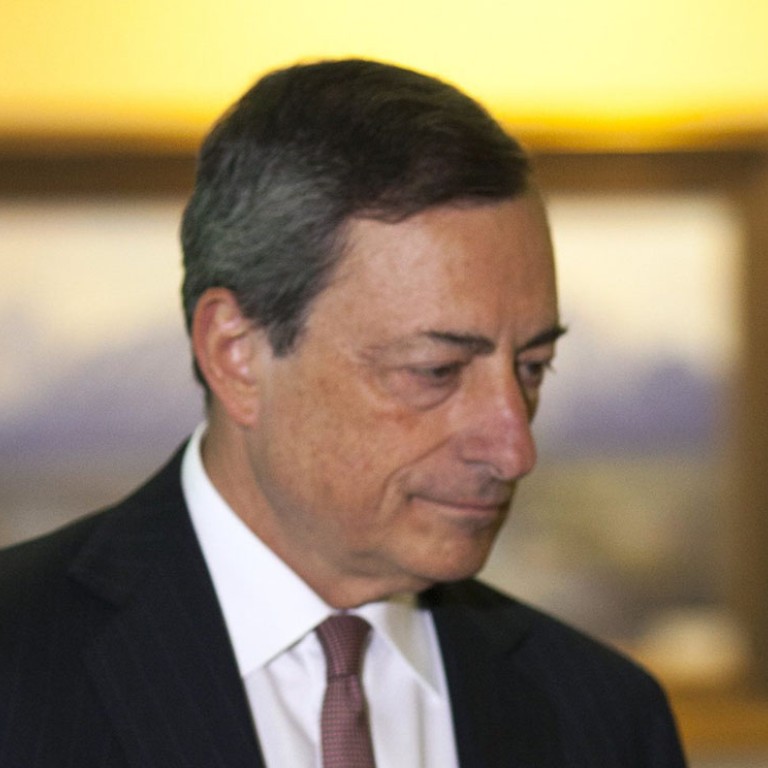
Time for ECB to man the quantitative easing pumps
To spur economic growth in the euro zone, Draghi needs to act quickly and boldly in the purchase programmes before it is too late
The European Central Bank has been long on promises and short on delivery for too long. Two years after president Mario Draghi pledged to do "whatever it takes" to save the euro, the euro zone is still sinking into an abyss of deflation and recession.
The euro zone is fast reaching a point of no return. Quantitative easing by the ECB - buying bonds and printing money - could be its last chance for survival.
So far, ECB policy has failed spectacularly. The euro has been close to collapse in recent years. Strong headwinds continue to batter the economy, with growth grinding to a halt. Economic confidence has been in retreat for months due mainly to weak internal demand.
The fallout from the euro-zone financial crisis - debt deflation, deleveraging and acute fiscal austerity - has taken a toll on confidence. Consumer sentiment has been pummelled by record unemployment, an income squeeze and negative wealth effects. Company output and investment plans have been shelved as optimism has tumbled.
The ECB missed an opportunity in the early phase of the crisis to co-ordinate simultaneous quantitative easing with the United States, Britain and Japan. Collective monetary intervention would have been a much more effective counterpunch to global recession and deflationary forces in their early stages. Intractable German Bundesbank dogma was probably to blame.
From 2009, the US, Britain and Japan threw their full weight behind quantitative easing, proving that "printing money" could revitalise demand and boost growth. Gross domestic product growth in the US and Britain accelerated to more than 3 per cent, while rapid job creation turned the tide on high unemployment. Japan's "two lost decades" of recession, stagnation and deflation were brought to an end with renewed quantitative easing initiatives under Abenomics.
There is still a window of opportunity for the ECB to make up for lost time and embrace quantitative easing, but it is closing fast.
Draghi's comments at last week's Jackson Hole summit were hardly encouraging. He said the ECB might be ready to act if inflation fell further, but maintained it would continue to gauge the impact of June's stimulus steps - dipping interest rates into negative territory and extra liquidity provisions - before making the next move.
The danger is when quantitative easing finally arrives, it may be too late and the measures lack conviction. The ECB has intimated it may draw up blueprints for an easing programme worth €1 trillion (HK$10.3 trillion) of asset purchases to ward off deflation. But this is not enough - it would only represent a meagre 7 per cent of the euro zone's GDP. The central bank needs to raise the bar much higher.
The ECB needs at least to match the quantitative easing investments put in by the US Federal Reserve and the Bank of England to get roughly similar results. The purchase programmes in the US and Britain amounted to about 22 per cent of nominal GDP from 2009 onwards. In Japan's case, the extra measures equalled about 28 per cent of GDP.
Euro-zone regeneration should not stop at quantitative easing. Policymakers need to orchestrate a radical plan of action - "Euronomics" - to ensure its future economic success - and political survival. It should be a comprehensive strategy, combining monetary, fiscal and currency stimulus, reinforced by structural reforms to help rebuild economic prosperity.
As an urgent priority, the ECB must unleash a shock wave of quantitative easing in the next few months. Euro-zone governments should abandon budget austerity as soon as possible, making way for fiscal reflation. The ECB needs to target 2 per cent inflation with sustainable growth of more than 2.5 per cent in the medium term.
The strong-euro mantra should be ditched in favour of a 15 to 20 per cent currency devaluation to boost export competitiveness and growth. Common euro-zone government bonds should be adopted to cap any future speculative attacks on weaker countries.
But without quantitative easing soon, the euro, the monetary union and the euro-zone dream could be damaged beyond repair.

